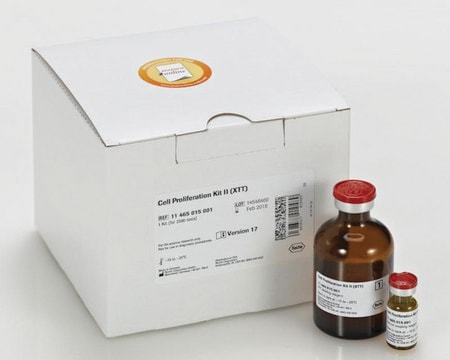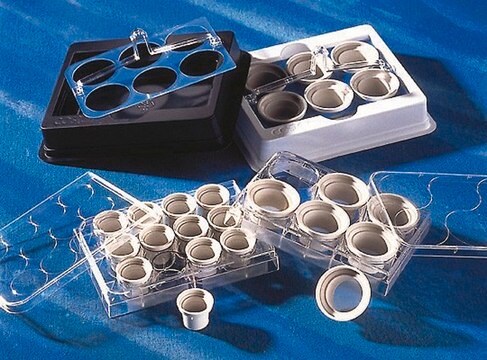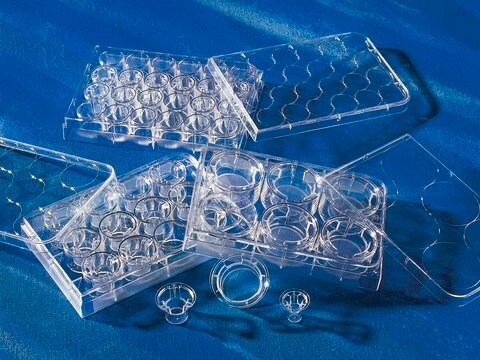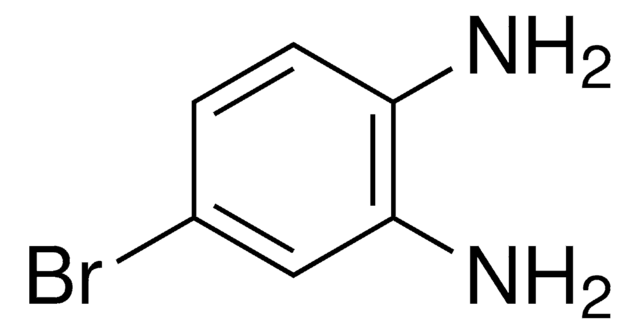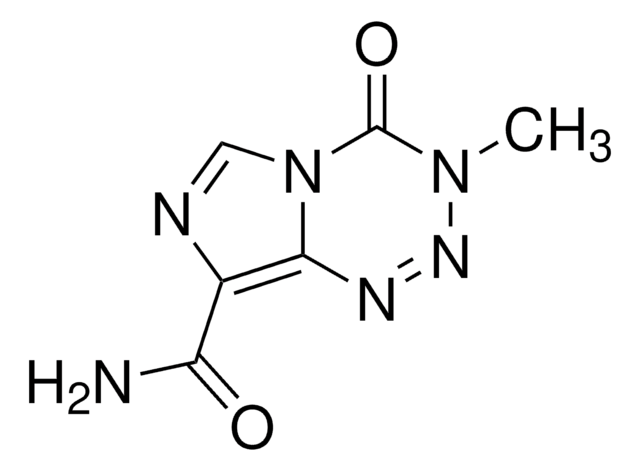95102433
BEAS-2B Cell Line human
Autenticatiper visualizzare i prezzi riservati alla tua organizzazione & contrattuali
About This Item
Codice UNSPSC:
41106514
Prodotti consigliati
Origine biologica
human lung
Livello qualitativo
Descrizione
Human bronchial epithelium, normal
Stato
liquid
Modalità di accrescimento
Adherent
Cariotipo
Not specified
Morfologia
Epithelial-like
Prodotti
Not specified
Recettori
Not specified
tecniche
cell culture | mammalian: suitable
Condizioni di spedizione
dry ice
Temperatura di conservazione
−196°C
Origine della linea cellulare
Human bronchial epithelium, normal
Descrizione della linea cellulare
BEAS-2B cells were derived from normal bronchial epithelium obtained from autopsy of non-cancerous individuals. Cells were infected with a replication-defective SV40/adenovirus 12 hybrid and cloned. Squamous differentiation can be observed in response to serum. This ability can be used for screening chemical and biological agents inducing or affecting differentiation and/or carcinogenesis. The cell line has been applied for studies of pneumococcal infection mechanisms. BEAS-2B was described to express keratins and SV40 T antigen. Subculturing the cells before confluency is necessary as confluent cultures rapidly undergo squamous terminal differentiation.
Applicazioni
BEAS-2B Cell line has been used to study differentiation of squamous cells and effect of biological and chemical agents on differentiation.
Profilo DNA
STR-PCR Data: Amelogenin: X,Y
CSF1PO: 9,12
D13S317: 13
D16S539: 12
D5S818: 12,13
D7S820: 10,13
THO1: 7,9.3
TPOX: 6,11
vWA: 17,18
CSF1PO: 9,12
D13S317: 13
D16S539: 12
D5S818: 12,13
D7S820: 10,13
THO1: 7,9.3
TPOX: 6,11
vWA: 17,18
Terreno di coltura
BEGM, also known as LHC-9 with modification (available from Clonetics Corporation, CC3171 (BEBM) plus additives CC4175 or BEGM Bullet Kit, CC3170); Note: Additives supplied contain gentamycin which has been omitted for culture at ECACC; media is serum-free.
Mantenimento delle subcolture
Passage sub-confluent cultures using 0.25% trypsin or trypsin/EDTA. Incubate at room temperature for 5-10 min until cells detach. Add fresh medium and disperse cells, centrifuge and resuspend pellet in medium. Seed into new flasks at 1500 to 3000 cells per cm2. Flasks have to be precoated with a mixture of 0.01 mg/ml fibronectin, 0.03 mg/ml collagen and 0.001 mg/ml bovine serum albumin dissolved in BEGM. Add mixture at ratio of 0.2 ml per cm2 surface area. Incubate at 5% CO2, 37°C for at least 6 hours at 37oC. Remove excess fluid and allow flasks to dry by incubating at 37oC overnight, leaving the caps loose. Prior to addition of cells wash flask three times with PBS. Note: BEGM medium is almost serum-free, therefore trypsin inhibitor is essential. Add an equal or greater volume of trypsin inhibitor as trypsin used before, centrifuge and reseed cells in collagen coated flasks using culture medium.
Altre note
Additional freight & handling charges may be applicable for Asia-Pacific shipments. Please check with your local Customer Service representative for more information.
Cultures from HPA Culture Collections and supplied by Sigma are for research purposes only. Enquiries regarding the commercial use of a cell line are referred to the depositor of the cell line. Some cell lines have additional special release conditions such as the requirement for a material transfer agreement to be completed by the potential recipient prior to the supply of the cell line.
Please view the Terms & Conditions of Supply for more information.
Cultures from HPA Culture Collections and supplied by Sigma are for research purposes only. Enquiries regarding the commercial use of a cell line are referred to the depositor of the cell line. Some cell lines have additional special release conditions such as the requirement for a material transfer agreement to be completed by the potential recipient prior to the supply of the cell line.
Please view the Terms & Conditions of Supply for more information.
Esclusione di responsabilità
RESEARCH USE ONLY. This product is regulated in France when intended to be used for scientific purposes, including for import and export activities (Article L 1211-1 paragraph 2 of the Public Health Code). The purchaser (i.e. enduser) is required to obtain an import authorization from the France Ministry of Research referred in the Article L1245-5-1 II. of Public Health Code. By ordering this product, you are confirming that you have obtained the proper import authorization.
Codice della classe di stoccaggio
10 - Combustible liquids
Classe di pericolosità dell'acqua (WGK)
WGK 3
Punto d’infiammabilità (°F)
Not applicable
Punto d’infiammabilità (°C)
Not applicable
Scegli una delle versioni più recenti:
Certificati d'analisi (COA)
Lot/Batch Number
Ci dispiace, ma al momento non ci sono COA disponibili online per questo prodotto.
Se ti serve aiuto, non esitare a contattarci Servizio Clienti
Possiedi già questo prodotto?
I documenti relativi ai prodotti acquistati recentemente sono disponibili nell’Archivio dei documenti.
An antagonist of the platelet-activating factor receptor inhibits adherence of both nontypeable Haemophilus influenzae and Streptococcus pneumoniae to cultured human bronchial epithelial cells exposed to cigarette smoke
Shakti D Shukla
International Journal of Chronic Obstructive Pulmonary Disease, 11 (2016)
Induction of altered mRNA expression profiles caused by fibrous and granular dust
Simone Helmig
Molecular Medicine Reports (2013)
J E Adamou et al.
Infection and immunity, 66(2), 820-822 (1998-02-07)
Pneumococcal adherence to alveolar epithelial cells and nasopharyngeal epithelial cells has been well characterized. However, the interaction of Streptococcus pneumoniae with bronchial epithelial cells has not been studied. We have now shown that pneumococci bind specifically to a human bronchial
The Expression of the Ubiquitin Ligase SIAH2 (Seven In Absentia Homolog 2) Is Increased in Human Lung Cancer
Paula Moreno
PLoS ONE (2015)
Proinflammatory effects and oxidative stress within human bronchial
epithelial cells exposed to atmospheric particulate matter (PM2.5 and
PM>2.5) collected from Cotonou, Benin
epithelial cells exposed to atmospheric particulate matter (PM2.5 and
PM>2.5) collected from Cotonou, Benin
Boris Fresnel Cachon
Environmental Pollution (Barking, Essex : 1987) (2014)
Il team dei nostri ricercatori vanta grande esperienza in tutte le aree della ricerca quali Life Science, scienza dei materiali, sintesi chimica, cromatografia, discipline analitiche, ecc..
Contatta l'Assistenza Tecnica.

